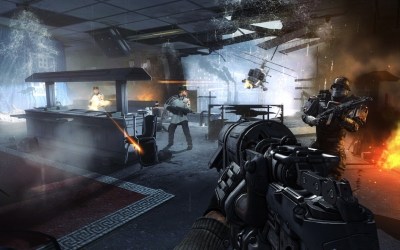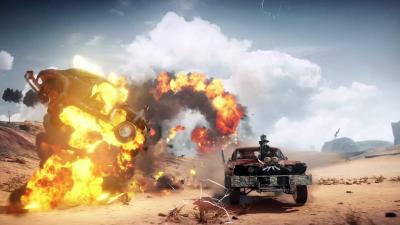It’s no secret that the First-Person Shooter genre is a huge part of the videogame industry.
Call of Duty and Battlefield have fiercely fought to stamp their mark as the king of modern warfare in recent years, a label that Call of Duty no longer seems satisfied with. The likes of co-op shooters such as Borderlands and Destiny, meanwhile, show that consumers expectations of the FPS are growing: they want bigger, more open, persistent worlds with sophisticated networking features. And publishers seem to agree, as evidenced by Activision’s phenomenal investment in Destiny, making it the most expensive project they’ve ever greenlit.
These days, if you’re launching a new console you practically need an FPS to sell it, be it a mediocre launch title like Killzone, or a massively hyped new IP such as Respawn’s Titanfall.
So how brazen is it of Wolfenstein: The New Order to ride up with no multiplayer, no persistent open-world, and take us back to an era where seemingly every game being released involved killing Nazis (again!), and yet another American jarhead protagonist with a jar-shaped head so jar-shaped that you begin to question whether he resembles jars, or if jars resemble him.
 The original 1992 release of Wolfenstein 3D was a humble game that took an old side-scrolling shoot em up and brought into the 3rd dimension (or at least a clever illusion of it, created through sprite scaling and ray tracing), kickstarting the entire FPS genre. But that was over 20 years ago and for Wolfenstein: The New Order to come to the party in 2014 with only a brand name almost smacks of arrogance - or, at the very least, an almost insane amount of courage.
The original 1992 release of Wolfenstein 3D was a humble game that took an old side-scrolling shoot em up and brought into the 3rd dimension (or at least a clever illusion of it, created through sprite scaling and ray tracing), kickstarting the entire FPS genre. But that was over 20 years ago and for Wolfenstein: The New Order to come to the party in 2014 with only a brand name almost smacks of arrogance - or, at the very least, an almost insane amount of courage.
Our expectations going into The New Order were perhaps a little low, but in part it was precisely because we expected little that we were consistently surprised by it, and in part because of the smart design choices that give The New Order a distinctive identity amongst a sea of samey, generic shooters.
The premise is simple enough: the game is set in an alternate take on history and you play as B.J. Blazkowicz - an American soldier that was part of the last resistance against general Deathshead’s Nazi regime. Seemingly overnight, the Nazi’s secured a technological advantage over their enemies and proceeded to subjugate neighboring nations. Blazkowicz’s unit’s mission to assassinate Deathshead ends in failure, and he’s carted off to a mental asylum where he wastes away 14 years in a PTSD-fuelled daydream. Upon awaking in the 1960s he’s shocked to find the world has been conquered by the Nazi regime and the the last dregs of the resistance are behind bars. But this wouldn’t be jingoistic pro-American gun-porn if the white hero didn’t rise up to single-handedly strike down his oppressor in a shower of bullet casings.
But here’s the first area where The New Order’s inventive remixing of stale elements yields surprising results - it isn’t that game. With the Nazis effectively in control of the world, the hero’s struggle becomes one of freedom versus oppression, rather than America versus the enemy. And Blazkowicz isn’t alone in this fight, he’ll be accompanied by a cast of colorful freedom fighters of various nationalities - characters who have enough aesthetic panache that they’d almost look at home in Borderlands: there’s a whimsical laid-back scientist, a wheelchair bound commander who pumps iron and eats Nazis for breakfast and a smart-mouthed British war hero, and these are just a small sample of the characters you’ll meet who go beyond being the usual voice-in-your-ear.
You’ll be a seeing a whole lot of these characters, too. Given how story-heavy The New Order is for a franchise built on arcade-like, no-frills shooting, it’s actually pleasantly surprising to find that, while on the surface the game remains almost defiantly old-school in its design philosophy, spending some time with it reveals a title which is actually far more of a departure for the series than you’d first suspect. And that jar-headed anti-hero fronting the game? Turns out he’s a positive, socially adjusted plain-old regular hero, complete with a heart of gold. The New Order is like that; it’s never shy of bucking modern game trends to serve the overall design of the game. But it isn’t averse to them when their inclusion serves the game.
And this contrasting philosophy permeates The New Order at every level. Yes, it has trappings of modern game design: lengthy, polished cutscenes and a backstory delivered by audio logs; and yes, it includes relatively modern game design elements: cover, lean mechanics, skill trees and recovering health are all present and correct. But it also includes old-school sensibilities, allowing you to carry a truckload of weapons at once instead of being limited to two (because, well, fuck reality), and you’ll pick up health packs and armor just as was once normal for the genre. You can also gain access to Easter Eggs, cheats and unlockables the good old-fashioned way, before invasive DLC became the norm - by playing the game from corner to corner. The New Order is a smart, sensible cohesion of the old and new rather than an internal struggle or compromise between them.
Take the gameplay for instance. Blaskowicz runs-and-guns Nazi foot soldiers, mechs and Panzerhunds (mechanical dogs) in a non-stop blur of sprinting-and-sliding between cover and popping-and-shooting. It’s a back-to-basics approach to shooting that emphasizes constant movement facilitated by open, circular level design: you’ll walk into a research facility lobby with scores of enemies between you and the doors on the far side, attack from the front, take any of a number of side-passages (and any of the passageways that branch from them), or maybe consider going under the enemy and circling around. Or if you want, you can assault the walkways on the ceilings and commandeer a gun turret.
All these approaches can work, and if they don’t, you can always keep on your feet, weaving between the interconnected paths as you mix up the game plan. The result is that you’re rarely pinned down behind cover or facing a dead end, though conversely you’re at risk of attack from all sides - making combat feel frenzied and omnidirectional. All the more reason to keep on your feet.
The New Order is structured so that most of the time players are afforded the choice of some variant of pistol, rifle, pulse rifle and shotgun (in single or dual-wield modes). Run out of ammo for one weapon? Just cycle onto the next. Players can not only keep running, but thanks to the generous arsenal and ammo, they can keeping gunning, too.
The New Order is at its best when it gives players options, but there a few are times when it doesn’t, and it’s to the games’ detriment. Towards the last third of the game, you’re confronted by several difficulty spikes which hit in quick succession - and all of them are due to the game reverting back to the restrictive funnel-like design that it originally aims to avoid. We attempted to battle our way up a straight highway with barely a brick to hide behind more times than we would have liked to, and one level late into the game restricts Blaskowicz’s arsenal to weapons that have to be cumbersomely refueled at charging stations, long after the novelty of doing so wears off.
And it’s a shame, as The New Order is otherwise filled with options, and not just for attack vector. Running in guns blazing and assaulting enemies is often just as valid as stealthily moving through an area with throwing knives and silenced pistols. It’s a paradigm which the skill trees in the perk system also share. Playing stealthily unlocks more stealth-related skills such as silenced footsteps, whereas playing loudly nets bonuses conducive to a no-nonsense approach such as larger clip sizes. These skills don’t have to be unlocked sequentially, and they aren’t mutually exclusive - allowing the player to experiment with or even mix and match perks from different trees.
Having an easy time gunning your way through an enemy encampment? Why not go for that stealth perk and mix things up by stealthing it instead? The kind of fun normally reserved for trophy runs or achievement heists are a welcome addition to regular play.
 This variety is also part of the moment-to-moment gameplay as well; Blaskowicz can become a juggernaut by collecting armor to displace damage that would directly affect his health, but he can also do the same by binging on medkits and overcharging his health past 100%. The two styles are both useful for rushdowns but they differ in that overcharged health degenerates back down to 100% over time. But here’s where it get’s interesting, although a tiny portion (around one fifth) of Blaskowicz’s health regenerates, the majority of it can only be restored by medkit.
This variety is also part of the moment-to-moment gameplay as well; Blaskowicz can become a juggernaut by collecting armor to displace damage that would directly affect his health, but he can also do the same by binging on medkits and overcharging his health past 100%. The two styles are both useful for rushdowns but they differ in that overcharged health degenerates back down to 100% over time. But here’s where it get’s interesting, although a tiny portion (around one fifth) of Blaskowicz’s health regenerates, the majority of it can only be restored by medkit.
Passing up the temporary boost of overcharged health for the permanency of an actual heal is a legitimate choice that leads to variation in approach; we often chose to forgo picking up medkits, deciding having a heal on standby was more useful, and in turn we played more cautiously, judiciously making use of stealth, cover and leaning. This didn’t stop us from experimenting with a more gung-ho approach on our second playthrough though, that and the added incentive of trying out different perks and seeing the (minor) variations in the story make The New Order the kind of game you’ll want to play twice.
The variance in mood, setting and scenario is another area where The New Order surprises and surpasses expectations; slinking through sewers and air ducts or taking on a Nazi office with nothing but a knife are not only welcome breaks from the arcade-y shooting, they’re just as much a part of the game - around a quarter of which is low octane downtime that does a great job of breaking up the action.
But not all variance is equally welcome. The story veers from being a dark look at an alternative history of Nazism, to being a relatively light-hearted story of freedom fighters taking down a comic supervillian. Sometimes the two co-exist peacefully, but at others Blaskowicz’s gravelly narration adds so much gravitas to proceedings that it seems forced. The game can’t seem to decide if Blaskowicz is a tragic, scarred war vet or a tireless optimist. He can’t be both at once, or at least The New Order doesn’t provide any compelling reasons for how he could be. Players will hang on the story as it develops, but leave unsatisfied.
Graphically, the game can often be impressive, but there are many instances where getting too close to a piece of scenery exposes some horrendously low-resolution textures. There are also some issues with characters getting stuck on or clipping through scenery, which detract from the overall level of polish. It’s a sign of the game’s long development history and origins, and need to perform, on last-gen consoles. It’s only made more obvious by some of the character animation and faces, which often look a little stiff and unconvincing. There’s also some texture pop-in, particularly when turning to look behind you - an old flaw with the idTech 5 engine on which it’s based.
It’s a shame, because Machine Games’ vision of a Nazi-dominated world in the throes of the Swinging Sixties often throws up some highly imaginative design work, with the traditional Nazi attire re-imagined through the lens of the fashion trends of the time, and enemy designs that are distinctive and varied enough that you can tell the art team had a blast conceiving the various opponents you’ll find yourself facing - though some, like swarms of airborne drones, can be annoyingly difficult to hit.
The sound, however, consistently impresses. Weapons feel suitably powerful, voice acting is surprisingly good throughout - even when the script descends into comic-book cliche - while a bombastic score is contrasted against the inclusion of real-life pop songs from the period, which only adds to the atmosphere. Overall, the audio work is remarkably solid, and it’s an area with little to complain about.
Wolfenstein: The New Order does a lot right in the 10 or so hours it takes to clear it. It mixes old and new elements in a quantity and combination which benefits the overall game design, never seeking to placate or pander to two different audiences. It surprises often, shattering expectations of you might expect to be a monotonous corridor slog through waves of enemies. And there’s enough variance in the perk system, story and moment-to-moment strategy that playing it twice is almost mandatory. Is it let down by some difficulty spikes, a disappointing final act and an inconsistent narrative tone?
Yes.
Does it suffer for not having a multiplayer mode or any of the other newfandangled features developers trip over themselves to cram into modern games?
Not in the slightest.




